NRSG263 Assignment: Restrictive Practices in Mental Health Nursing
VerifiedAdded on 2022/08/29
|10
|2848
|15
Essay
AI Summary
This essay critically analyzes coercive and restrictive practices within the context of mental health nursing, drawing upon national and international perspectives. It explores the historical use of seclusion and restraint, highlighting their potential for human rights abuses and negative impacts on patient well-being, including physical and psychological injury. The paper examines the views of patients, carers, and advocates, who often report these practices as non-therapeutic and traumatic. The role of registered nurses in minimizing restrictive interventions, promoting recovery-oriented care, and adhering to ethical and legal guidelines is also discussed. The analysis considers the importance of cultural sensitivity, particularly in caring for Aboriginal individuals, and emphasizes the need for de-escalation techniques and alternative approaches to managing patient aggression. Finally, the essay underscores the significance of high-quality clinical treatment, monitoring, and the development of team performance to reduce the reliance on coercive measures and improve the overall quality of mental health care.
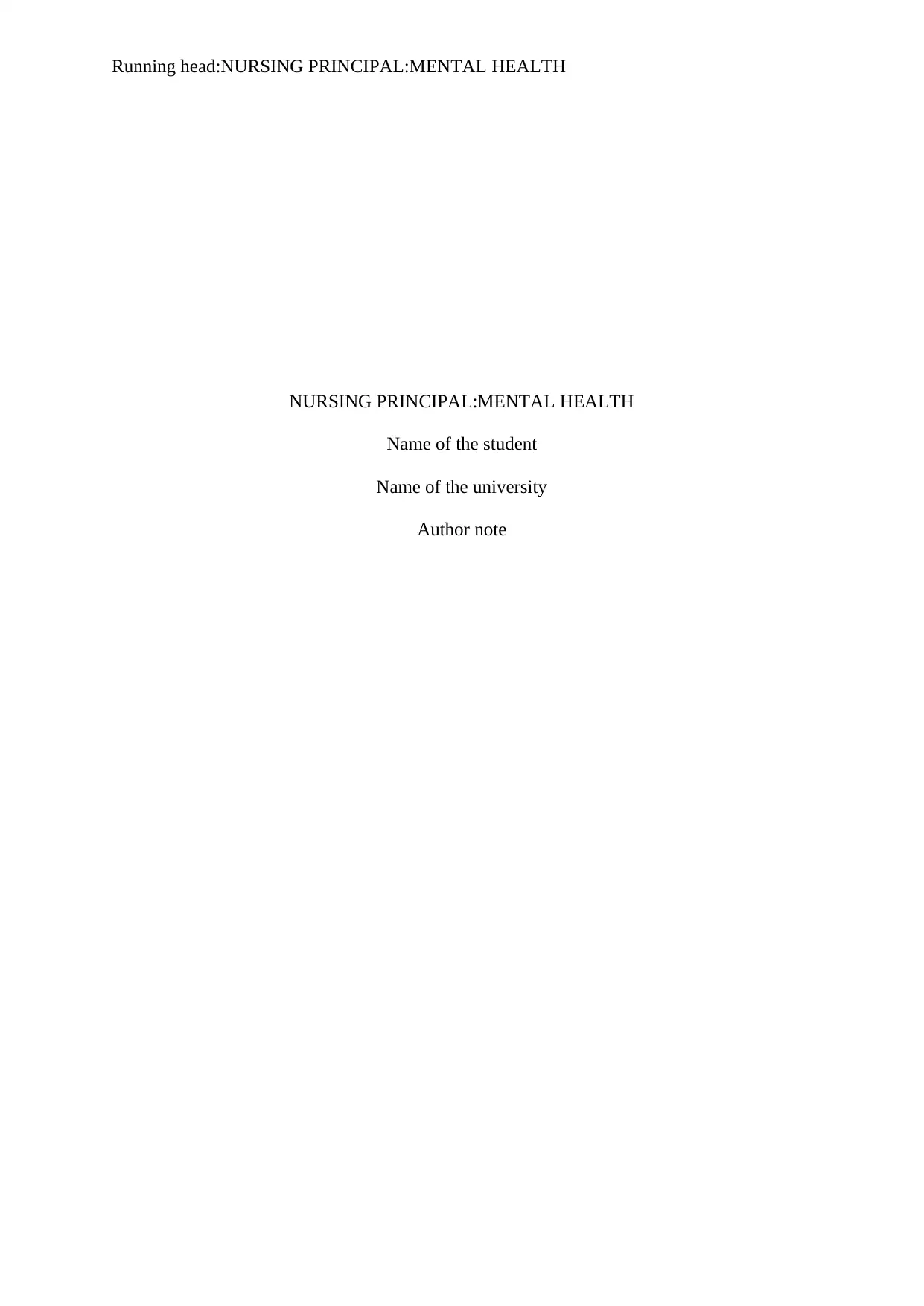
Running head:NURSING PRINCIPAL:MENTAL HEALTH
NURSING PRINCIPAL:MENTAL HEALTH
Name of the student
Name of the university
Author note
NURSING PRINCIPAL:MENTAL HEALTH
Name of the student
Name of the university
Author note
Paraphrase This Document
Need a fresh take? Get an instant paraphrase of this document with our AI Paraphraser
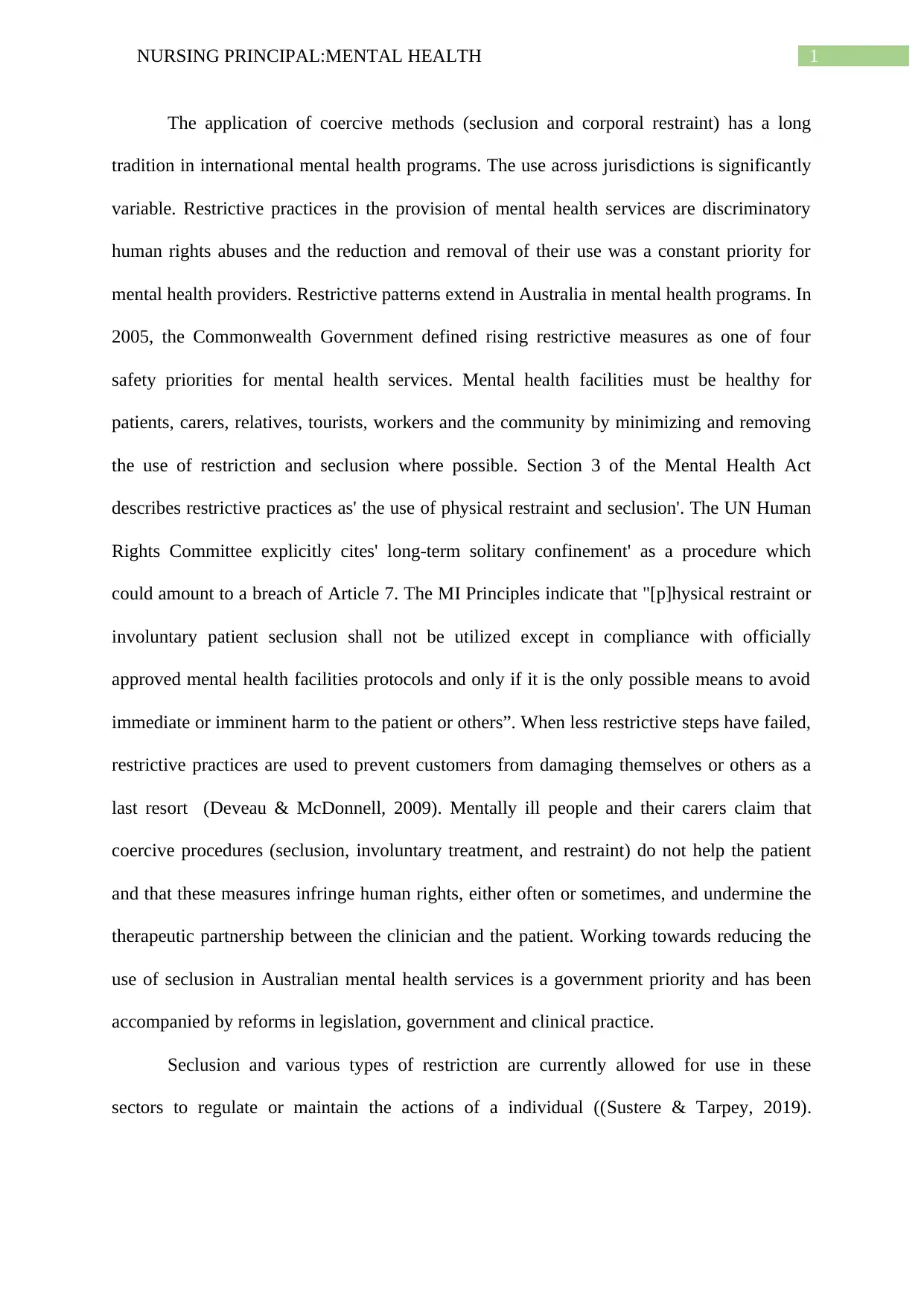
1NURSING PRINCIPAL:MENTAL HEALTH
The application of coercive methods (seclusion and corporal restraint) has a long
tradition in international mental health programs. The use across jurisdictions is significantly
variable. Restrictive practices in the provision of mental health services are discriminatory
human rights abuses and the reduction and removal of their use was a constant priority for
mental health providers. Restrictive patterns extend in Australia in mental health programs. In
2005, the Commonwealth Government defined rising restrictive measures as one of four
safety priorities for mental health services. Mental health facilities must be healthy for
patients, carers, relatives, tourists, workers and the community by minimizing and removing
the use of restriction and seclusion where possible. Section 3 of the Mental Health Act
describes restrictive practices as' the use of physical restraint and seclusion'. The UN Human
Rights Committee explicitly cites' long-term solitary confinement' as a procedure which
could amount to a breach of Article 7. The MI Principles indicate that "[p]hysical restraint or
involuntary patient seclusion shall not be utilized except in compliance with officially
approved mental health facilities protocols and only if it is the only possible means to avoid
immediate or imminent harm to the patient or others”. When less restrictive steps have failed,
restrictive practices are used to prevent customers from damaging themselves or others as a
last resort (Deveau & McDonnell, 2009). Mentally ill people and their carers claim that
coercive procedures (seclusion, involuntary treatment, and restraint) do not help the patient
and that these measures infringe human rights, either often or sometimes, and undermine the
therapeutic partnership between the clinician and the patient. Working towards reducing the
use of seclusion in Australian mental health services is a government priority and has been
accompanied by reforms in legislation, government and clinical practice.
Seclusion and various types of restriction are currently allowed for use in these
sectors to regulate or maintain the actions of a individual ((Sustere & Tarpey, 2019).
The application of coercive methods (seclusion and corporal restraint) has a long
tradition in international mental health programs. The use across jurisdictions is significantly
variable. Restrictive practices in the provision of mental health services are discriminatory
human rights abuses and the reduction and removal of their use was a constant priority for
mental health providers. Restrictive patterns extend in Australia in mental health programs. In
2005, the Commonwealth Government defined rising restrictive measures as one of four
safety priorities for mental health services. Mental health facilities must be healthy for
patients, carers, relatives, tourists, workers and the community by minimizing and removing
the use of restriction and seclusion where possible. Section 3 of the Mental Health Act
describes restrictive practices as' the use of physical restraint and seclusion'. The UN Human
Rights Committee explicitly cites' long-term solitary confinement' as a procedure which
could amount to a breach of Article 7. The MI Principles indicate that "[p]hysical restraint or
involuntary patient seclusion shall not be utilized except in compliance with officially
approved mental health facilities protocols and only if it is the only possible means to avoid
immediate or imminent harm to the patient or others”. When less restrictive steps have failed,
restrictive practices are used to prevent customers from damaging themselves or others as a
last resort (Deveau & McDonnell, 2009). Mentally ill people and their carers claim that
coercive procedures (seclusion, involuntary treatment, and restraint) do not help the patient
and that these measures infringe human rights, either often or sometimes, and undermine the
therapeutic partnership between the clinician and the patient. Working towards reducing the
use of seclusion in Australian mental health services is a government priority and has been
accompanied by reforms in legislation, government and clinical practice.
Seclusion and various types of restriction are currently allowed for use in these
sectors to regulate or maintain the actions of a individual ((Sustere & Tarpey, 2019).
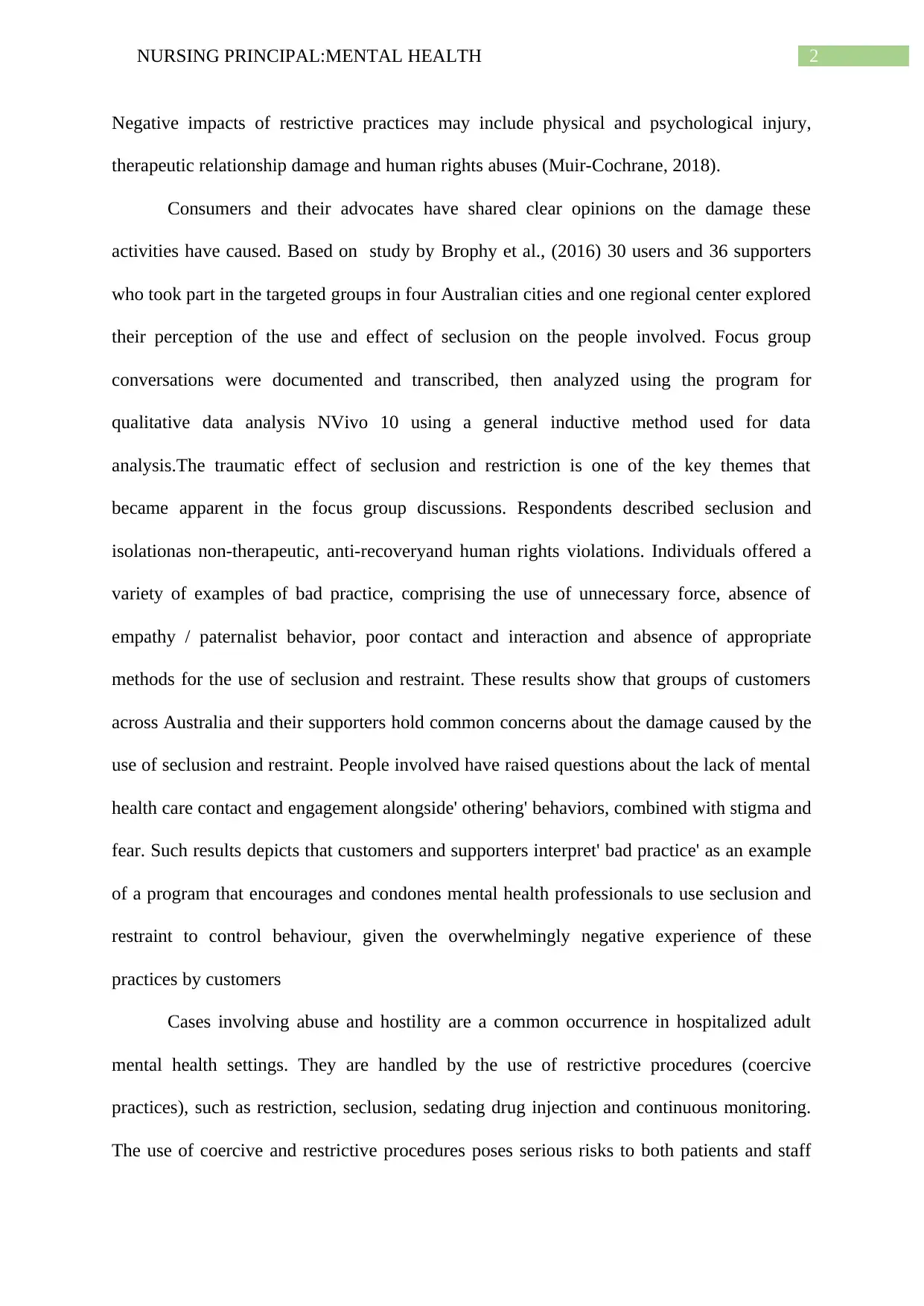
2NURSING PRINCIPAL:MENTAL HEALTH
Negative impacts of restrictive practices may include physical and psychological injury,
therapeutic relationship damage and human rights abuses (Muir-Cochrane, 2018).
Consumers and their advocates have shared clear opinions on the damage these
activities have caused. Based on study by Brophy et al., (2016) 30 users and 36 supporters
who took part in the targeted groups in four Australian cities and one regional center explored
their perception of the use and effect of seclusion on the people involved. Focus group
conversations were documented and transcribed, then analyzed using the program for
qualitative data analysis NVivo 10 using a general inductive method used for data
analysis.The traumatic effect of seclusion and restriction is one of the key themes that
became apparent in the focus group discussions. Respondents described seclusion and
isolationas non-therapeutic, anti-recoveryand human rights violations. Individuals offered a
variety of examples of bad practice, comprising the use of unnecessary force, absence of
empathy / paternalist behavior, poor contact and interaction and absence of appropriate
methods for the use of seclusion and restraint. These results show that groups of customers
across Australia and their supporters hold common concerns about the damage caused by the
use of seclusion and restraint. People involved have raised questions about the lack of mental
health care contact and engagement alongside' othering' behaviors, combined with stigma and
fear. Such results depicts that customers and supporters interpret' bad practice' as an example
of a program that encourages and condones mental health professionals to use seclusion and
restraint to control behaviour, given the overwhelmingly negative experience of these
practices by customers
Cases involving abuse and hostility are a common occurrence in hospitalized adult
mental health settings. They are handled by the use of restrictive procedures (coercive
practices), such as restriction, seclusion, sedating drug injection and continuous monitoring.
The use of coercive and restrictive procedures poses serious risks to both patients and staff
Negative impacts of restrictive practices may include physical and psychological injury,
therapeutic relationship damage and human rights abuses (Muir-Cochrane, 2018).
Consumers and their advocates have shared clear opinions on the damage these
activities have caused. Based on study by Brophy et al., (2016) 30 users and 36 supporters
who took part in the targeted groups in four Australian cities and one regional center explored
their perception of the use and effect of seclusion on the people involved. Focus group
conversations were documented and transcribed, then analyzed using the program for
qualitative data analysis NVivo 10 using a general inductive method used for data
analysis.The traumatic effect of seclusion and restriction is one of the key themes that
became apparent in the focus group discussions. Respondents described seclusion and
isolationas non-therapeutic, anti-recoveryand human rights violations. Individuals offered a
variety of examples of bad practice, comprising the use of unnecessary force, absence of
empathy / paternalist behavior, poor contact and interaction and absence of appropriate
methods for the use of seclusion and restraint. These results show that groups of customers
across Australia and their supporters hold common concerns about the damage caused by the
use of seclusion and restraint. People involved have raised questions about the lack of mental
health care contact and engagement alongside' othering' behaviors, combined with stigma and
fear. Such results depicts that customers and supporters interpret' bad practice' as an example
of a program that encourages and condones mental health professionals to use seclusion and
restraint to control behaviour, given the overwhelmingly negative experience of these
practices by customers
Cases involving abuse and hostility are a common occurrence in hospitalized adult
mental health settings. They are handled by the use of restrictive procedures (coercive
practices), such as restriction, seclusion, sedating drug injection and continuous monitoring.
The use of coercive and restrictive procedures poses serious risks to both patients and staff
⊘ This is a preview!⊘
Do you want full access?
Subscribe today to unlock all pages.

Trusted by 1+ million students worldwide
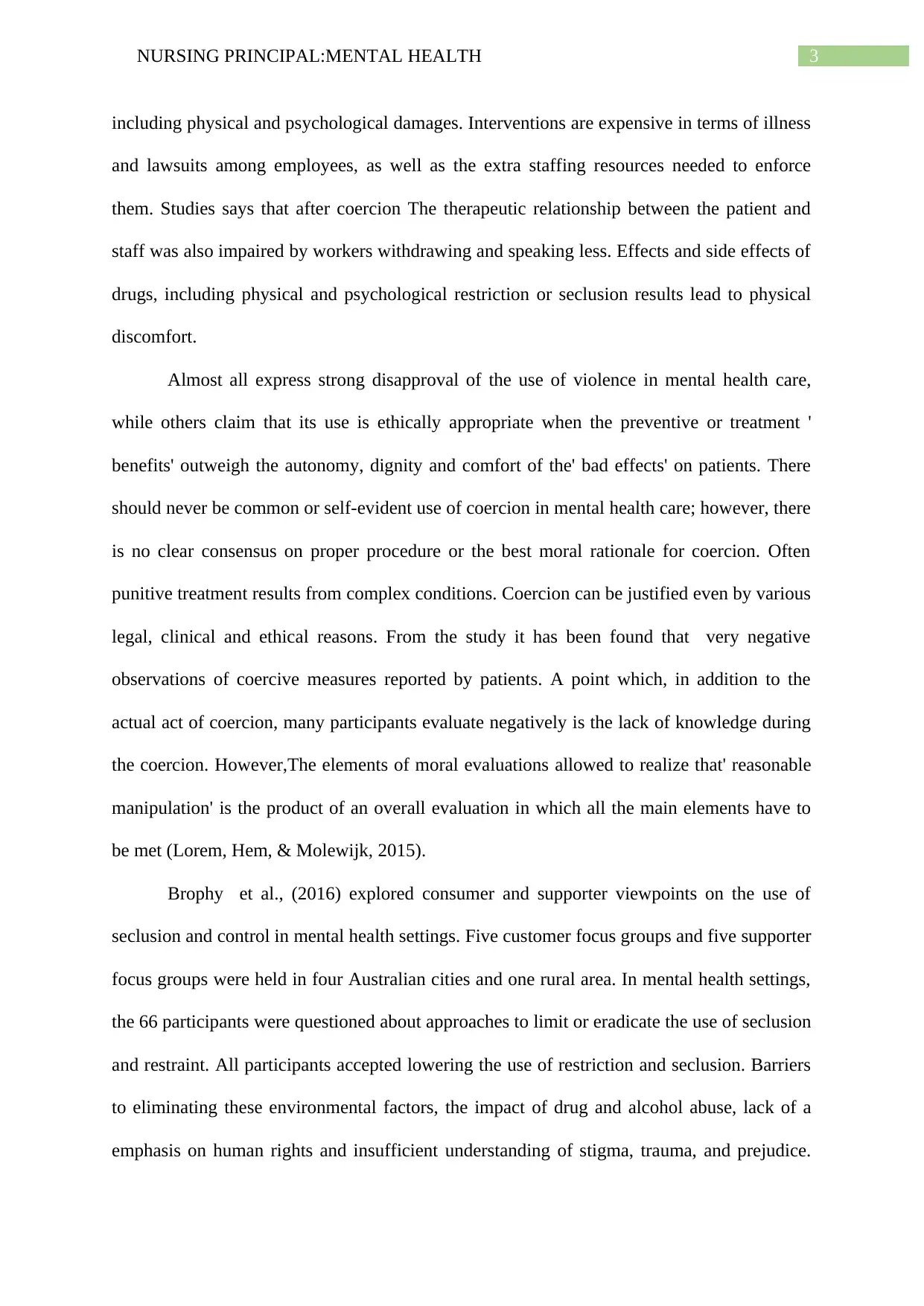
3NURSING PRINCIPAL:MENTAL HEALTH
including physical and psychological damages. Interventions are expensive in terms of illness
and lawsuits among employees, as well as the extra staffing resources needed to enforce
them. Studies says that after coercion The therapeutic relationship between the patient and
staff was also impaired by workers withdrawing and speaking less. Effects and side effects of
drugs, including physical and psychological restriction or seclusion results lead to physical
discomfort.
Almost all express strong disapproval of the use of violence in mental health care,
while others claim that its use is ethically appropriate when the preventive or treatment '
benefits' outweigh the autonomy, dignity and comfort of the' bad effects' on patients. There
should never be common or self-evident use of coercion in mental health care; however, there
is no clear consensus on proper procedure or the best moral rationale for coercion. Often
punitive treatment results from complex conditions. Coercion can be justified even by various
legal, clinical and ethical reasons. From the study it has been found that very negative
observations of coercive measures reported by patients. A point which, in addition to the
actual act of coercion, many participants evaluate negatively is the lack of knowledge during
the coercion. However,The elements of moral evaluations allowed to realize that' reasonable
manipulation' is the product of an overall evaluation in which all the main elements have to
be met (Lorem, Hem, & Molewijk, 2015).
Brophy et al., (2016) explored consumer and supporter viewpoints on the use of
seclusion and control in mental health settings. Five customer focus groups and five supporter
focus groups were held in four Australian cities and one rural area. In mental health settings,
the 66 participants were questioned about approaches to limit or eradicate the use of seclusion
and restraint. All participants accepted lowering the use of restriction and seclusion. Barriers
to eliminating these environmental factors, the impact of drug and alcohol abuse, lack of a
emphasis on human rights and insufficient understanding of stigma, trauma, and prejudice.
including physical and psychological damages. Interventions are expensive in terms of illness
and lawsuits among employees, as well as the extra staffing resources needed to enforce
them. Studies says that after coercion The therapeutic relationship between the patient and
staff was also impaired by workers withdrawing and speaking less. Effects and side effects of
drugs, including physical and psychological restriction or seclusion results lead to physical
discomfort.
Almost all express strong disapproval of the use of violence in mental health care,
while others claim that its use is ethically appropriate when the preventive or treatment '
benefits' outweigh the autonomy, dignity and comfort of the' bad effects' on patients. There
should never be common or self-evident use of coercion in mental health care; however, there
is no clear consensus on proper procedure or the best moral rationale for coercion. Often
punitive treatment results from complex conditions. Coercion can be justified even by various
legal, clinical and ethical reasons. From the study it has been found that very negative
observations of coercive measures reported by patients. A point which, in addition to the
actual act of coercion, many participants evaluate negatively is the lack of knowledge during
the coercion. However,The elements of moral evaluations allowed to realize that' reasonable
manipulation' is the product of an overall evaluation in which all the main elements have to
be met (Lorem, Hem, & Molewijk, 2015).
Brophy et al., (2016) explored consumer and supporter viewpoints on the use of
seclusion and control in mental health settings. Five customer focus groups and five supporter
focus groups were held in four Australian cities and one rural area. In mental health settings,
the 66 participants were questioned about approaches to limit or eradicate the use of seclusion
and restraint. All participants accepted lowering the use of restriction and seclusion. Barriers
to eliminating these environmental factors, the impact of drug and alcohol abuse, lack of a
emphasis on human rights and insufficient understanding of stigma, trauma, and prejudice.
Paraphrase This Document
Need a fresh take? Get an instant paraphrase of this document with our AI Paraphraser
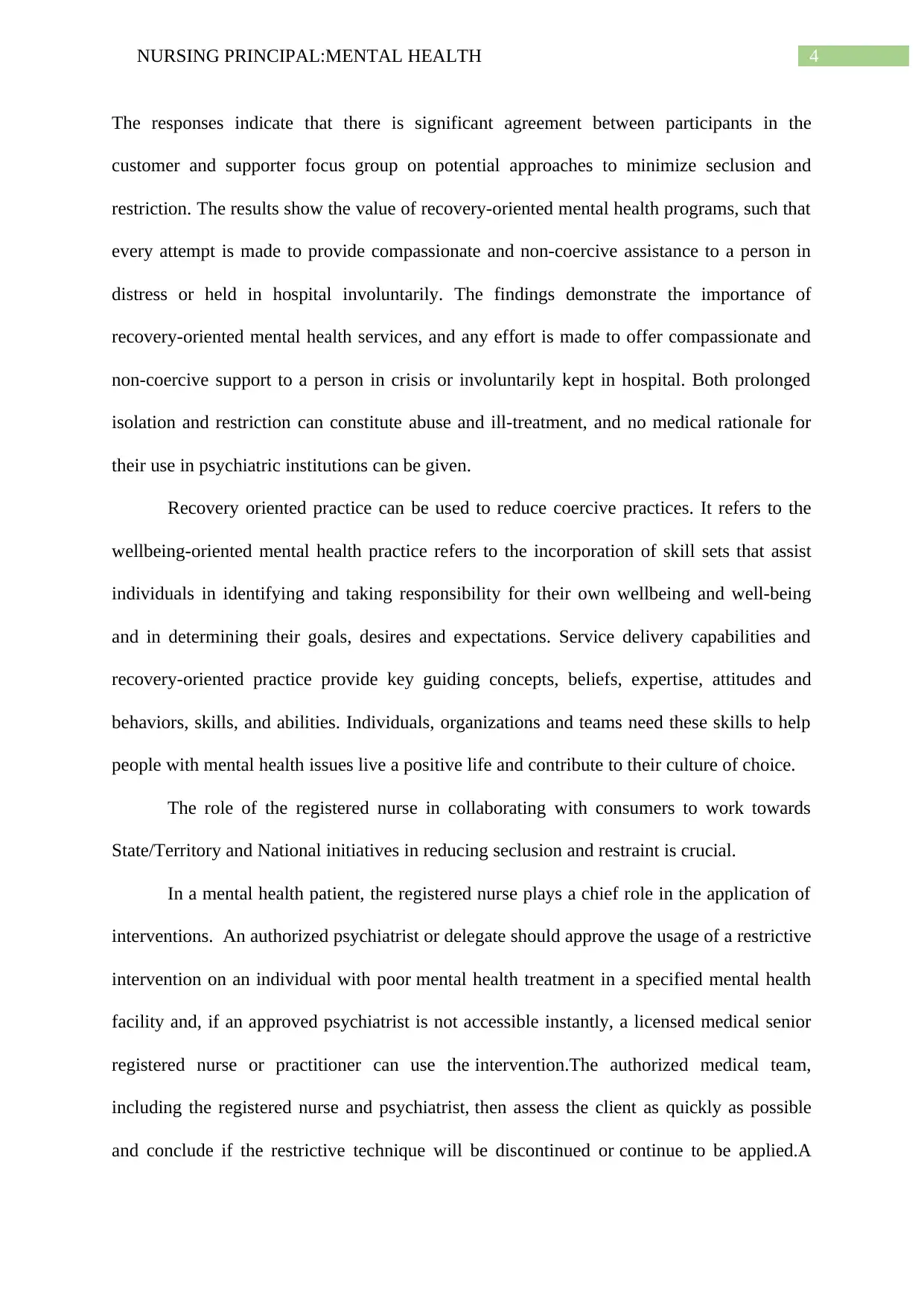
4NURSING PRINCIPAL:MENTAL HEALTH
The responses indicate that there is significant agreement between participants in the
customer and supporter focus group on potential approaches to minimize seclusion and
restriction. The results show the value of recovery-oriented mental health programs, such that
every attempt is made to provide compassionate and non-coercive assistance to a person in
distress or held in hospital involuntarily. The findings demonstrate the importance of
recovery-oriented mental health services, and any effort is made to offer compassionate and
non-coercive support to a person in crisis or involuntarily kept in hospital. Both prolonged
isolation and restriction can constitute abuse and ill-treatment, and no medical rationale for
their use in psychiatric institutions can be given.
Recovery oriented practice can be used to reduce coercive practices. It refers to the
wellbeing-oriented mental health practice refers to the incorporation of skill sets that assist
individuals in identifying and taking responsibility for their own wellbeing and well-being
and in determining their goals, desires and expectations. Service delivery capabilities and
recovery-oriented practice provide key guiding concepts, beliefs, expertise, attitudes and
behaviors, skills, and abilities. Individuals, organizations and teams need these skills to help
people with mental health issues live a positive life and contribute to their culture of choice.
The role of the registered nurse in collaborating with consumers to work towards
State/Territory and National initiatives in reducing seclusion and restraint is crucial.
In a mental health patient, the registered nurse plays a chief role in the application of
interventions. An authorized psychiatrist or delegate should approve the usage of a restrictive
intervention on an individual with poor mental health treatment in a specified mental health
facility and, if an approved psychiatrist is not accessible instantly, a licensed medical senior
registered nurse or practitioner can use the intervention.The authorized medical team,
including the registered nurse and psychiatrist, then assess the client as quickly as possible
and conclude if the restrictive technique will be discontinued or continue to be applied.A
The responses indicate that there is significant agreement between participants in the
customer and supporter focus group on potential approaches to minimize seclusion and
restriction. The results show the value of recovery-oriented mental health programs, such that
every attempt is made to provide compassionate and non-coercive assistance to a person in
distress or held in hospital involuntarily. The findings demonstrate the importance of
recovery-oriented mental health services, and any effort is made to offer compassionate and
non-coercive support to a person in crisis or involuntarily kept in hospital. Both prolonged
isolation and restriction can constitute abuse and ill-treatment, and no medical rationale for
their use in psychiatric institutions can be given.
Recovery oriented practice can be used to reduce coercive practices. It refers to the
wellbeing-oriented mental health practice refers to the incorporation of skill sets that assist
individuals in identifying and taking responsibility for their own wellbeing and well-being
and in determining their goals, desires and expectations. Service delivery capabilities and
recovery-oriented practice provide key guiding concepts, beliefs, expertise, attitudes and
behaviors, skills, and abilities. Individuals, organizations and teams need these skills to help
people with mental health issues live a positive life and contribute to their culture of choice.
The role of the registered nurse in collaborating with consumers to work towards
State/Territory and National initiatives in reducing seclusion and restraint is crucial.
In a mental health patient, the registered nurse plays a chief role in the application of
interventions. An authorized psychiatrist or delegate should approve the usage of a restrictive
intervention on an individual with poor mental health treatment in a specified mental health
facility and, if an approved psychiatrist is not accessible instantly, a licensed medical senior
registered nurse or practitioner can use the intervention.The authorized medical team,
including the registered nurse and psychiatrist, then assess the client as quickly as possible
and conclude if the restrictive technique will be discontinued or continue to be applied.A
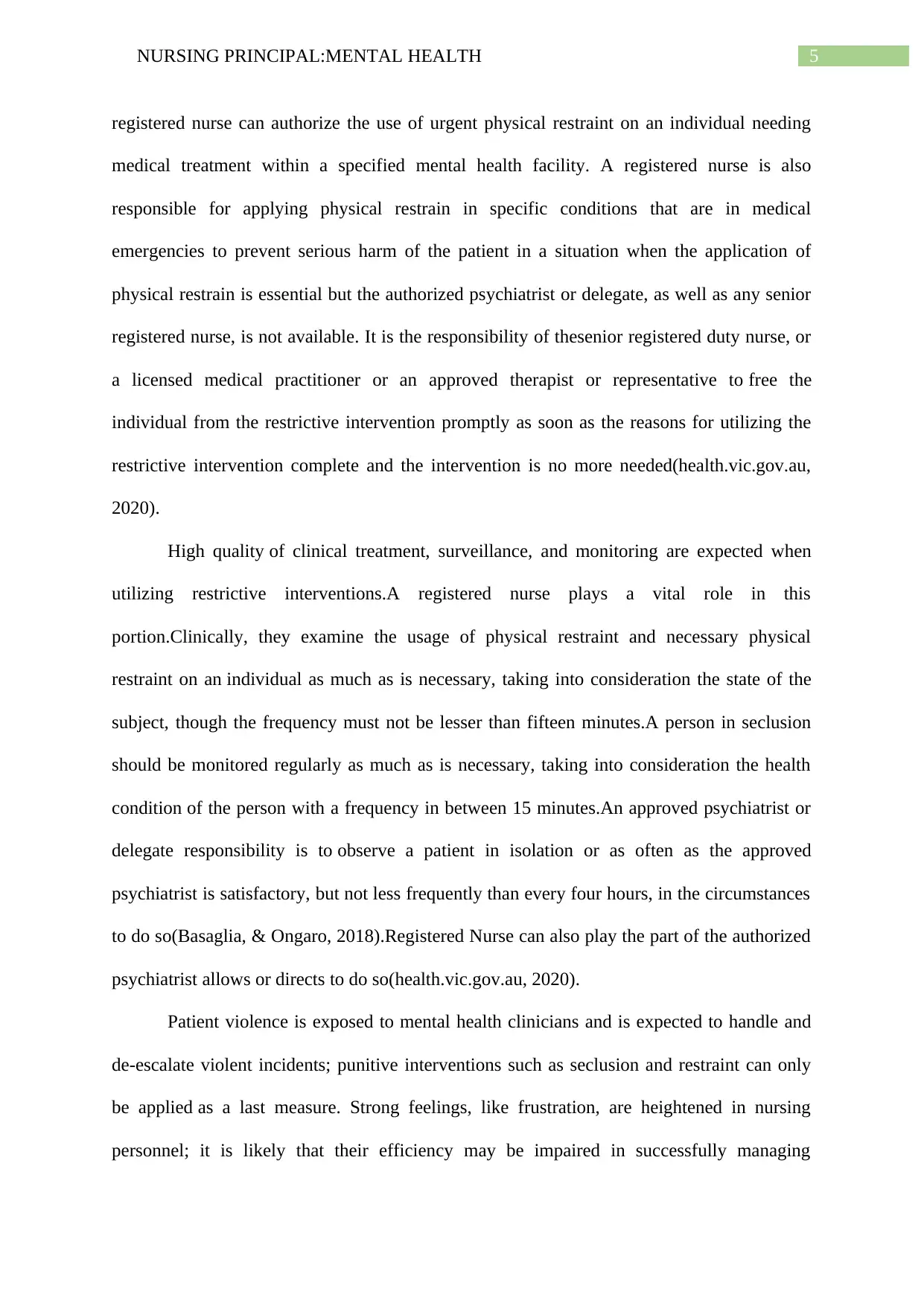
5NURSING PRINCIPAL:MENTAL HEALTH
registered nurse can authorize the use of urgent physical restraint on an individual needing
medical treatment within a specified mental health facility. A registered nurse is also
responsible for applying physical restrain in specific conditions that are in medical
emergencies to prevent serious harm of the patient in a situation when the application of
physical restrain is essential but the authorized psychiatrist or delegate, as well as any senior
registered nurse, is not available. It is the responsibility of thesenior registered duty nurse, or
a licensed medical practitioner or an approved therapist or representative to free the
individual from the restrictive intervention promptly as soon as the reasons for utilizing the
restrictive intervention complete and the intervention is no more needed(health.vic.gov.au,
2020).
High quality of clinical treatment, surveillance, and monitoring are expected when
utilizing restrictive interventions.A registered nurse plays a vital role in this
portion.Clinically, they examine the usage of physical restraint and necessary physical
restraint on an individual as much as is necessary, taking into consideration the state of the
subject, though the frequency must not be lesser than fifteen minutes.A person in seclusion
should be monitored regularly as much as is necessary, taking into consideration the health
condition of the person with a frequency in between 15 minutes.An approved psychiatrist or
delegate responsibility is to observe a patient in isolation or as often as the approved
psychiatrist is satisfactory, but not less frequently than every four hours, in the circumstances
to do so(Basaglia, & Ongaro, 2018).Registered Nurse can also play the part of the authorized
psychiatrist allows or directs to do so(health.vic.gov.au, 2020).
Patient violence is exposed to mental health clinicians and is expected to handle and
de-escalate violent incidents; punitive interventions such as seclusion and restraint can only
be applied as a last measure. Strong feelings, like frustration, are heightened in nursing
personnel; it is likely that their efficiency may be impaired in successfully managing
registered nurse can authorize the use of urgent physical restraint on an individual needing
medical treatment within a specified mental health facility. A registered nurse is also
responsible for applying physical restrain in specific conditions that are in medical
emergencies to prevent serious harm of the patient in a situation when the application of
physical restrain is essential but the authorized psychiatrist or delegate, as well as any senior
registered nurse, is not available. It is the responsibility of thesenior registered duty nurse, or
a licensed medical practitioner or an approved therapist or representative to free the
individual from the restrictive intervention promptly as soon as the reasons for utilizing the
restrictive intervention complete and the intervention is no more needed(health.vic.gov.au,
2020).
High quality of clinical treatment, surveillance, and monitoring are expected when
utilizing restrictive interventions.A registered nurse plays a vital role in this
portion.Clinically, they examine the usage of physical restraint and necessary physical
restraint on an individual as much as is necessary, taking into consideration the state of the
subject, though the frequency must not be lesser than fifteen minutes.A person in seclusion
should be monitored regularly as much as is necessary, taking into consideration the health
condition of the person with a frequency in between 15 minutes.An approved psychiatrist or
delegate responsibility is to observe a patient in isolation or as often as the approved
psychiatrist is satisfactory, but not less frequently than every four hours, in the circumstances
to do so(Basaglia, & Ongaro, 2018).Registered Nurse can also play the part of the authorized
psychiatrist allows or directs to do so(health.vic.gov.au, 2020).
Patient violence is exposed to mental health clinicians and is expected to handle and
de-escalate violent incidents; punitive interventions such as seclusion and restraint can only
be applied as a last measure. Strong feelings, like frustration, are heightened in nursing
personnel; it is likely that their efficiency may be impaired in successfully managing
⊘ This is a preview!⊘
Do you want full access?
Subscribe today to unlock all pages.

Trusted by 1+ million students worldwide
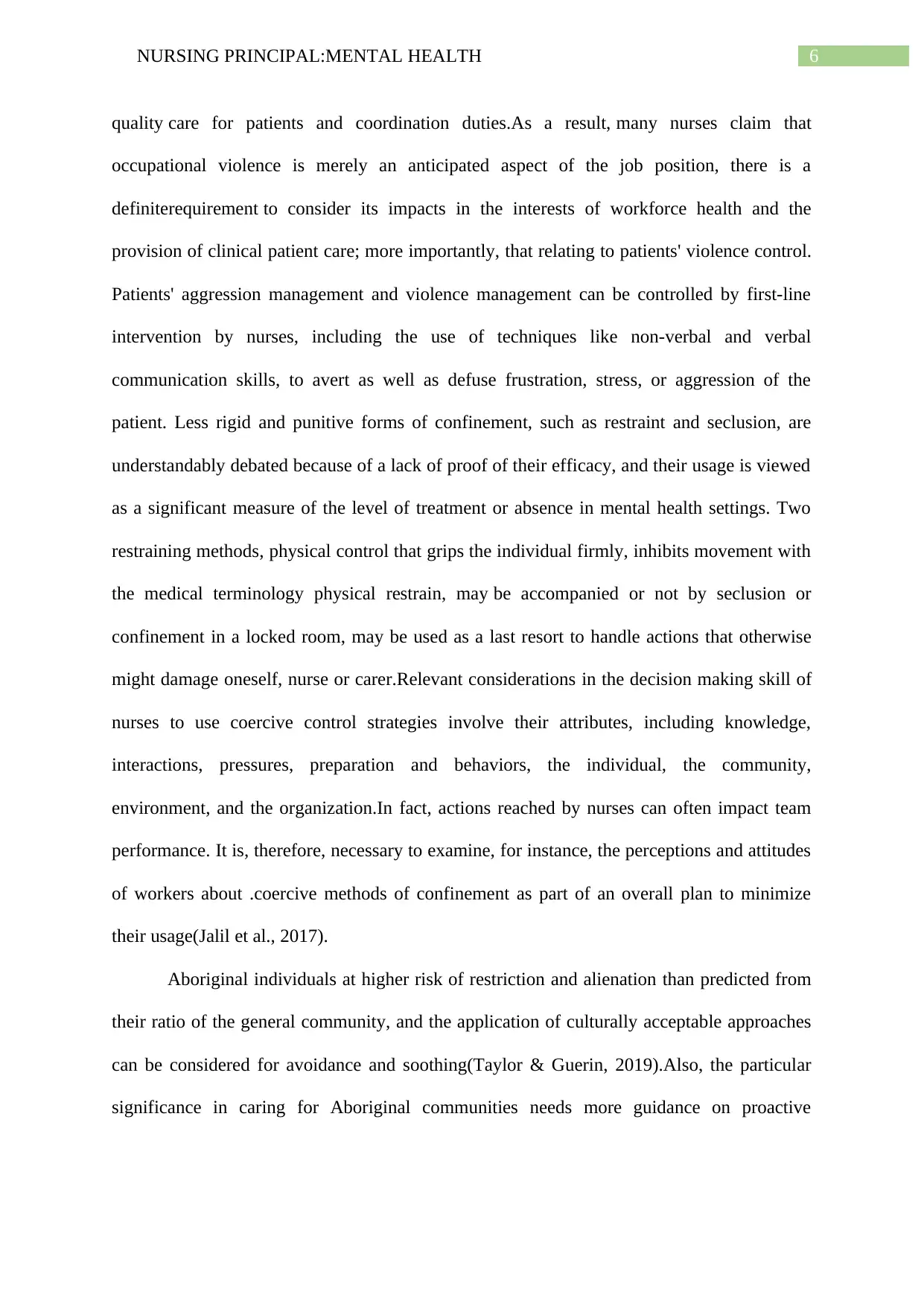
6NURSING PRINCIPAL:MENTAL HEALTH
quality care for patients and coordination duties.As a result, many nurses claim that
occupational violence is merely an anticipated aspect of the job position, there is a
definiterequirement to consider its impacts in the interests of workforce health and the
provision of clinical patient care; more importantly, that relating to patients' violence control.
Patients' aggression management and violence management can be controlled by first-line
intervention by nurses, including the use of techniques like non-verbal and verbal
communication skills, to avert as well as defuse frustration, stress, or aggression of the
patient. Less rigid and punitive forms of confinement, such as restraint and seclusion, are
understandably debated because of a lack of proof of their efficacy, and their usage is viewed
as a significant measure of the level of treatment or absence in mental health settings. Two
restraining methods, physical control that grips the individual firmly, inhibits movement with
the medical terminology physical restrain, may be accompanied or not by seclusion or
confinement in a locked room, may be used as a last resort to handle actions that otherwise
might damage oneself, nurse or carer.Relevant considerations in the decision making skill of
nurses to use coercive control strategies involve their attributes, including knowledge,
interactions, pressures, preparation and behaviors, the individual, the community,
environment, and the organization.In fact, actions reached by nurses can often impact team
performance. It is, therefore, necessary to examine, for instance, the perceptions and attitudes
of workers about .coercive methods of confinement as part of an overall plan to minimize
their usage(Jalil et al., 2017).
Aboriginal individuals at higher risk of restriction and alienation than predicted from
their ratio of the general community, and the application of culturally acceptable approaches
can be considered for avoidance and soothing(Taylor & Guerin, 2019).Also, the particular
significance in caring for Aboriginal communities needs more guidance on proactive
quality care for patients and coordination duties.As a result, many nurses claim that
occupational violence is merely an anticipated aspect of the job position, there is a
definiterequirement to consider its impacts in the interests of workforce health and the
provision of clinical patient care; more importantly, that relating to patients' violence control.
Patients' aggression management and violence management can be controlled by first-line
intervention by nurses, including the use of techniques like non-verbal and verbal
communication skills, to avert as well as defuse frustration, stress, or aggression of the
patient. Less rigid and punitive forms of confinement, such as restraint and seclusion, are
understandably debated because of a lack of proof of their efficacy, and their usage is viewed
as a significant measure of the level of treatment or absence in mental health settings. Two
restraining methods, physical control that grips the individual firmly, inhibits movement with
the medical terminology physical restrain, may be accompanied or not by seclusion or
confinement in a locked room, may be used as a last resort to handle actions that otherwise
might damage oneself, nurse or carer.Relevant considerations in the decision making skill of
nurses to use coercive control strategies involve their attributes, including knowledge,
interactions, pressures, preparation and behaviors, the individual, the community,
environment, and the organization.In fact, actions reached by nurses can often impact team
performance. It is, therefore, necessary to examine, for instance, the perceptions and attitudes
of workers about .coercive methods of confinement as part of an overall plan to minimize
their usage(Jalil et al., 2017).
Aboriginal individuals at higher risk of restriction and alienation than predicted from
their ratio of the general community, and the application of culturally acceptable approaches
can be considered for avoidance and soothing(Taylor & Guerin, 2019).Also, the particular
significance in caring for Aboriginal communities needs more guidance on proactive
Paraphrase This Document
Need a fresh take? Get an instant paraphrase of this document with our AI Paraphraser
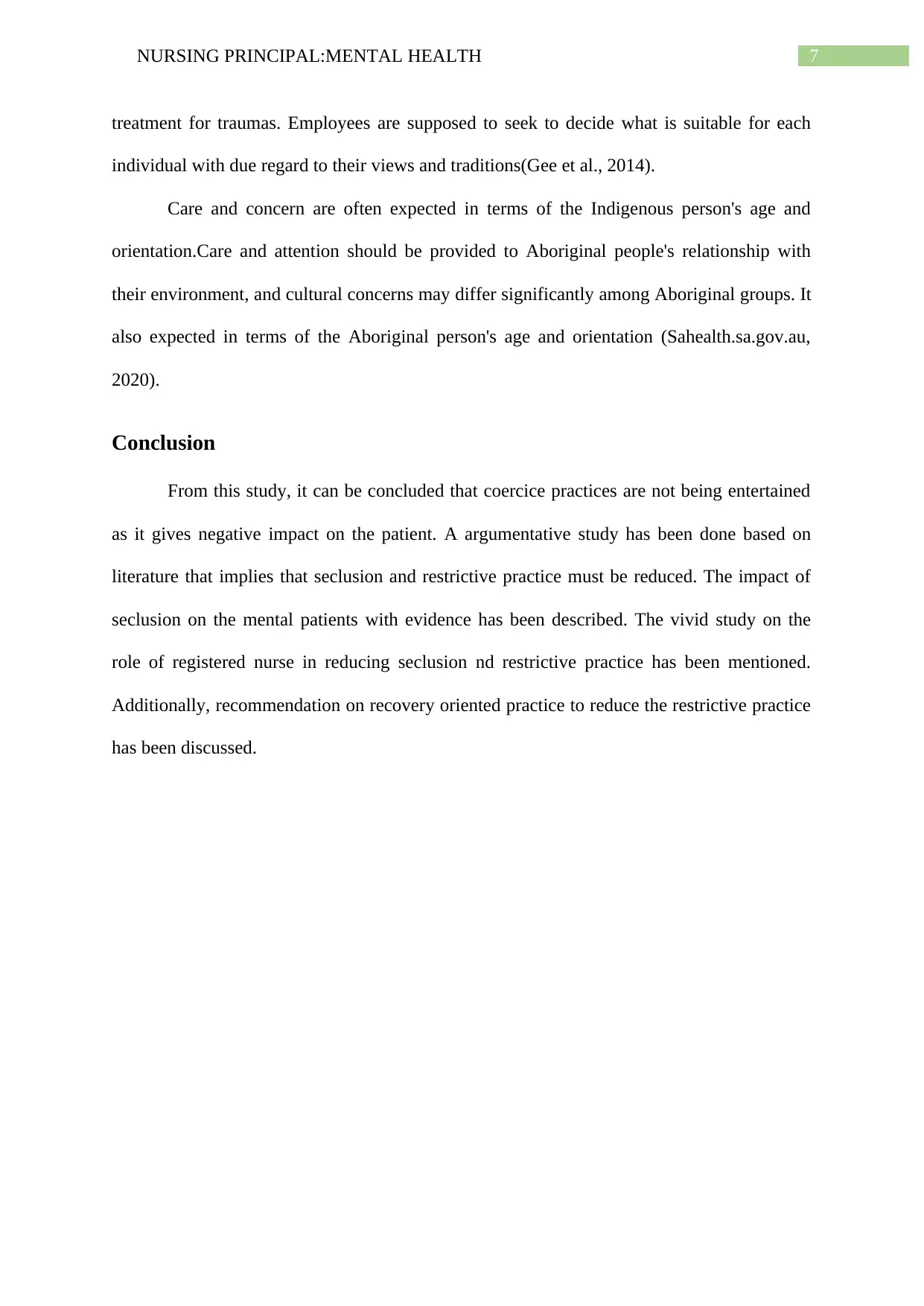
7NURSING PRINCIPAL:MENTAL HEALTH
treatment for traumas. Employees are supposed to seek to decide what is suitable for each
individual with due regard to their views and traditions(Gee et al., 2014).
Care and concern are often expected in terms of the Indigenous person's age and
orientation.Care and attention should be provided to Aboriginal people's relationship with
their environment, and cultural concerns may differ significantly among Aboriginal groups. It
also expected in terms of the Aboriginal person's age and orientation (Sahealth.sa.gov.au,
2020).
Conclusion
From this study, it can be concluded that coercice practices are not being entertained
as it gives negative impact on the patient. A argumentative study has been done based on
literature that implies that seclusion and restrictive practice must be reduced. The impact of
seclusion on the mental patients with evidence has been described. The vivid study on the
role of registered nurse in reducing seclusion nd restrictive practice has been mentioned.
Additionally, recommendation on recovery oriented practice to reduce the restrictive practice
has been discussed.
treatment for traumas. Employees are supposed to seek to decide what is suitable for each
individual with due regard to their views and traditions(Gee et al., 2014).
Care and concern are often expected in terms of the Indigenous person's age and
orientation.Care and attention should be provided to Aboriginal people's relationship with
their environment, and cultural concerns may differ significantly among Aboriginal groups. It
also expected in terms of the Aboriginal person's age and orientation (Sahealth.sa.gov.au,
2020).
Conclusion
From this study, it can be concluded that coercice practices are not being entertained
as it gives negative impact on the patient. A argumentative study has been done based on
literature that implies that seclusion and restrictive practice must be reduced. The impact of
seclusion on the mental patients with evidence has been described. The vivid study on the
role of registered nurse in reducing seclusion nd restrictive practice has been mentioned.
Additionally, recommendation on recovery oriented practice to reduce the restrictive practice
has been discussed.
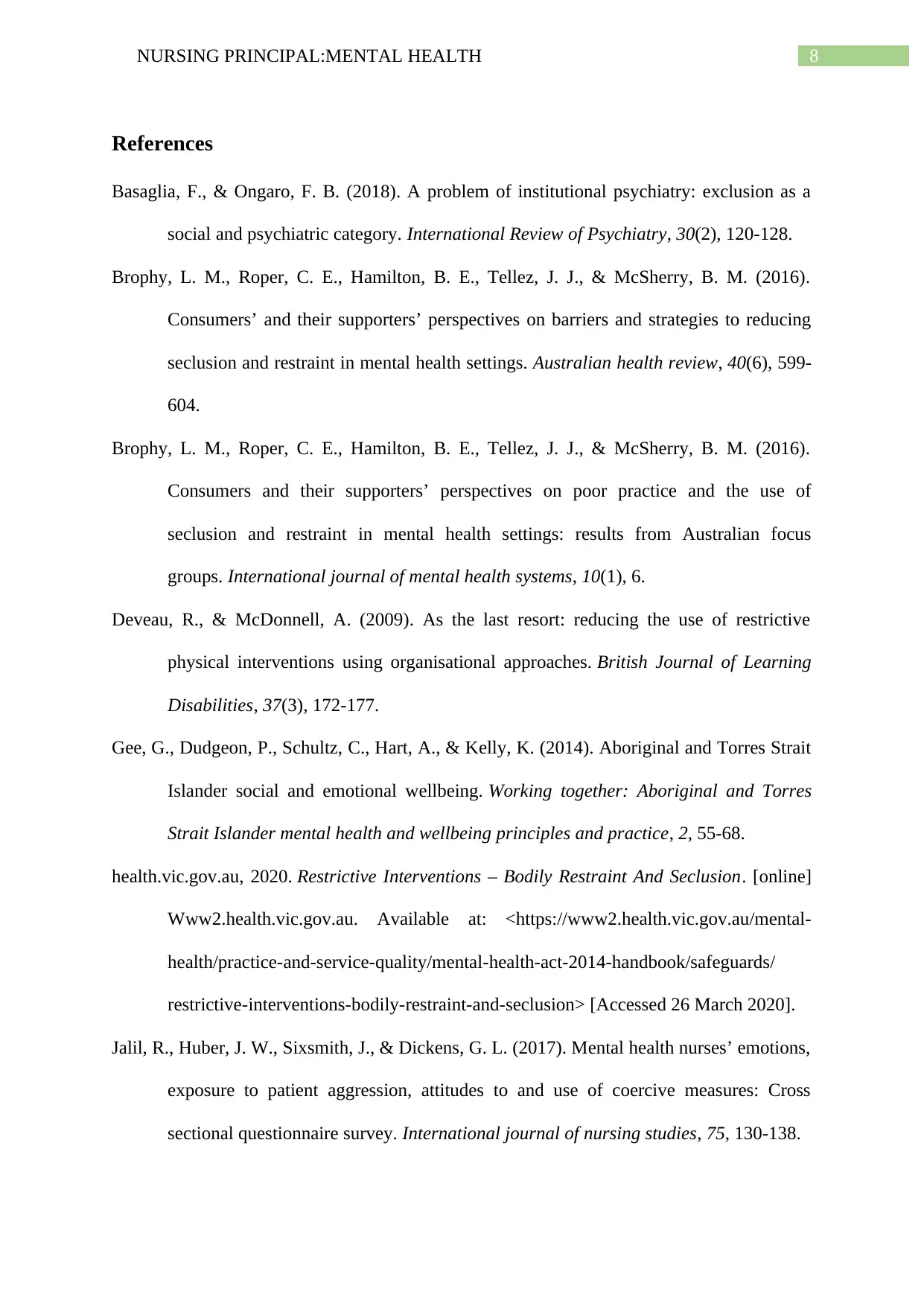
8NURSING PRINCIPAL:MENTAL HEALTH
References
Basaglia, F., & Ongaro, F. B. (2018). A problem of institutional psychiatry: exclusion as a
social and psychiatric category. International Review of Psychiatry, 30(2), 120-128.
Brophy, L. M., Roper, C. E., Hamilton, B. E., Tellez, J. J., & McSherry, B. M. (2016).
Consumers’ and their supporters’ perspectives on barriers and strategies to reducing
seclusion and restraint in mental health settings. Australian health review, 40(6), 599-
604.
Brophy, L. M., Roper, C. E., Hamilton, B. E., Tellez, J. J., & McSherry, B. M. (2016).
Consumers and their supporters’ perspectives on poor practice and the use of
seclusion and restraint in mental health settings: results from Australian focus
groups. International journal of mental health systems, 10(1), 6.
Deveau, R., & McDonnell, A. (2009). As the last resort: reducing the use of restrictive
physical interventions using organisational approaches. British Journal of Learning
Disabilities, 37(3), 172-177.
Gee, G., Dudgeon, P., Schultz, C., Hart, A., & Kelly, K. (2014). Aboriginal and Torres Strait
Islander social and emotional wellbeing. Working together: Aboriginal and Torres
Strait Islander mental health and wellbeing principles and practice, 2, 55-68.
health.vic.gov.au, 2020. Restrictive Interventions – Bodily Restraint And Seclusion. [online]
Www2.health.vic.gov.au. Available at: <https://www2.health.vic.gov.au/mental-
health/practice-and-service-quality/mental-health-act-2014-handbook/safeguards/
restrictive-interventions-bodily-restraint-and-seclusion> [Accessed 26 March 2020].
Jalil, R., Huber, J. W., Sixsmith, J., & Dickens, G. L. (2017). Mental health nurses’ emotions,
exposure to patient aggression, attitudes to and use of coercive measures: Cross
sectional questionnaire survey. International journal of nursing studies, 75, 130-138.
References
Basaglia, F., & Ongaro, F. B. (2018). A problem of institutional psychiatry: exclusion as a
social and psychiatric category. International Review of Psychiatry, 30(2), 120-128.
Brophy, L. M., Roper, C. E., Hamilton, B. E., Tellez, J. J., & McSherry, B. M. (2016).
Consumers’ and their supporters’ perspectives on barriers and strategies to reducing
seclusion and restraint in mental health settings. Australian health review, 40(6), 599-
604.
Brophy, L. M., Roper, C. E., Hamilton, B. E., Tellez, J. J., & McSherry, B. M. (2016).
Consumers and their supporters’ perspectives on poor practice and the use of
seclusion and restraint in mental health settings: results from Australian focus
groups. International journal of mental health systems, 10(1), 6.
Deveau, R., & McDonnell, A. (2009). As the last resort: reducing the use of restrictive
physical interventions using organisational approaches. British Journal of Learning
Disabilities, 37(3), 172-177.
Gee, G., Dudgeon, P., Schultz, C., Hart, A., & Kelly, K. (2014). Aboriginal and Torres Strait
Islander social and emotional wellbeing. Working together: Aboriginal and Torres
Strait Islander mental health and wellbeing principles and practice, 2, 55-68.
health.vic.gov.au, 2020. Restrictive Interventions – Bodily Restraint And Seclusion. [online]
Www2.health.vic.gov.au. Available at: <https://www2.health.vic.gov.au/mental-
health/practice-and-service-quality/mental-health-act-2014-handbook/safeguards/
restrictive-interventions-bodily-restraint-and-seclusion> [Accessed 26 March 2020].
Jalil, R., Huber, J. W., Sixsmith, J., & Dickens, G. L. (2017). Mental health nurses’ emotions,
exposure to patient aggression, attitudes to and use of coercive measures: Cross
sectional questionnaire survey. International journal of nursing studies, 75, 130-138.
⊘ This is a preview!⊘
Do you want full access?
Subscribe today to unlock all pages.

Trusted by 1+ million students worldwide

9NURSING PRINCIPAL:MENTAL HEALTH
Lorem, G. F., Hem, M. H., & Molewijk, B. (2015). Good coercion: Patients' moral evaluation
of coercion in mental health care. International journal of mental health
nursing, 24(3), 231-240.
Muir-Cochrane, E. (2018). On restrictive practices: Care and culture.
Sahealth.sa.gov.au. (2020). Retrieved 26 March 2020, from
https://www.sahealth.sa.gov.au/wps/wcm/connect/5dd2f58048f79928929df70e3d7ae4
ad/Guideline_restraint+and+seclusion_july2015.pdf?
MOD=AJPERES&CACHEID=5dd2f58048f79928929df70e3d7ae4ad
Sustere, E., & Tarpey, E. (2019). Least restrictive practice: its role in patient independence
and recovery. The Journal of Forensic Psychiatry & Psychology, 30(4), 614-629.
Taylor, K., & Guerin, P. (2019). Health care and Indigenous Australians: cultural safety in
practice. Macmillan International Higher Education.
Lorem, G. F., Hem, M. H., & Molewijk, B. (2015). Good coercion: Patients' moral evaluation
of coercion in mental health care. International journal of mental health
nursing, 24(3), 231-240.
Muir-Cochrane, E. (2018). On restrictive practices: Care and culture.
Sahealth.sa.gov.au. (2020). Retrieved 26 March 2020, from
https://www.sahealth.sa.gov.au/wps/wcm/connect/5dd2f58048f79928929df70e3d7ae4
ad/Guideline_restraint+and+seclusion_july2015.pdf?
MOD=AJPERES&CACHEID=5dd2f58048f79928929df70e3d7ae4ad
Sustere, E., & Tarpey, E. (2019). Least restrictive practice: its role in patient independence
and recovery. The Journal of Forensic Psychiatry & Psychology, 30(4), 614-629.
Taylor, K., & Guerin, P. (2019). Health care and Indigenous Australians: cultural safety in
practice. Macmillan International Higher Education.
1 out of 10
Related Documents
Your All-in-One AI-Powered Toolkit for Academic Success.
+13062052269
info@desklib.com
Available 24*7 on WhatsApp / Email
![[object Object]](/_next/static/media/star-bottom.7253800d.svg)
Unlock your academic potential
Copyright © 2020–2025 A2Z Services. All Rights Reserved. Developed and managed by ZUCOL.





